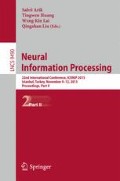Abstract
Association rule mining is the process of discovering useful and interesting rules from large datasets. Traditional association rule mining algorithms depend on a user specified minimum support and confidence values. These constraints introduce two major challenges in real world applications: exponential search space and a dataset dependent minimum support value. Data analyzers must specify suitable dataset dependent minimum support value for mining tasks although they might have no knowledge regarding the dataset and these algorithms generate a huge number of unnecessary rules. To overcome these kinds of problems, recently several researchers framed association rule mining problem as a multi objective problem. In this paper, we propose ARMGAAM, a new evolutionary algorithm, which generates a reduced set of association rules and optimizes several measures that are present in different degrees based on the datasets are used. To accomplish this, our method extends the existing ARMGA model for performing an evolutionary learning, while introducing a reinitialization process along with an adaptive mutation method. Moreover, this approach maximizes conditional probability, lift, net confidence and performance in order to obtain a set of rules which are interesting, useful and easy to comprehend. The effectiveness of the proposed method is validated over a few real world datasets.
Access this chapter
Tax calculation will be finalised at checkout
Purchases are for personal use only
References
Hipp, J., Güntzer, U., Nakhaeizadeh, G.: Algorithms for association rule mining—a general survey and comparison. ACM sigkdd Explor. 2(1), 58–64 (2000)
Han, J., Kamber, M.: Data Mining: Concepts and Techniques, 2nd edn. Morgan Kaufmann, Burlington (2006)
Yan, X., Zhang, C., Zhang, S.: Genetic algorithm-based strategy for identifying association rules without specifying actual minimum support. Expert Syst. Appl. 36(2), 3066–3076 (2009)
del Jesus, M.J., Gámez, J.A., González, P., Puerta, J.M.: On the discovery of association rules by means of evolutionary algorithms. Wiley Interdiscip. Rev. Data Min. Knowl. Discov. 1(5), 397–415 (2011)
Berzal, F., Blanco, I., Sánchez, D.: Measuring the accuracy and interest of association rules: a new framework. Intell. Data Anal. 6(3), 221–235 (2002)
Martin, D., Rosete, A., Alcala-Fdez, J., Herrera, F.: A new multiobjective evolutionary algorithm for mining a reduced set of interesting positive and negative quantitative association rules. IEEE Trans. Evol. Comput. 18(1), 54–69 (2014)
Mukhopadhyay, A., Maulik, U., Bandyopadhyay, S., Coello, C.A.C.: A survey of multiobjective evolutionary algorithms for data mining: Part i. IEEE Trans. Evol. Comput. 18(1), 4–19 (2014)
Maulik, U., Bandyopadhyay, S., Mukhopadhyay, A.: Multiobjective Genetic Algorithms for Clustering: Applications in Data Mining and Bioinformatics. Springer, Berlin (2011)
Shenoy, P., Srinivasa, K., Venugopal, K., Patnaik, L.: Evolutionary approach for mining association rules on dynamic databases. In: Proceeding of the 7th Pacific-Asia Conference on Advances in Knowledge Discovery and Data Mining, PAKDD, pp. 325–336 (2003)
Shenoy, P., Srinivasa, K., Venugopal, K., Patnaik, L.: Dynamic association rule mining using genetic algorithms. Intell. Data Anal. 9(5), 439–453 (2005)
Yan, X., Zhang, C., Zhang, S.: ARMGA: identifying interesting association rules with genetic algorithms. Appl. Artif. Intell. Int. J. 19(7), 677–689 (2005)
Alatas, B., Akin, E.: MODENAR: multi-objective differential evolution algorithm for mining numeric association rules. Appl. Soft Comput. 8(1), 646–656 (2008)
Ghosh, A., Nath, B.: Multi-objective rule mining using genetic algorithms. Inf. Sci. (Ny) 163(1–3), 123–133 (2004)
Salleb-aouissi, A., Vrain, C., Nortet, C., Kong, X., Cassard, D.: QuantMiner for mining quantitative association rules. Mach. Learn. Res. 14(1), 3153–3157 (2013)
Webb, G.I.: Discovering associations with numeric variables. In: Proceedings of the Seventh ACM SIGKDD International Conference on Knowledge Discovery and Data Mining, pp. 383–388 (2001)
Agrawal, R., Srikant, R.: Fast algorithms for mining association rules. In: 20th International Conference on Very Large Data Bases, pp. 487–499 (1994)
Borgelt, C.: Efficient implementations of Apriori and Eclat. In: IEEE ICDM Workshop on Frequent Item Set Mining Implementations, pp. 280–296 (2003)
Zaki, M.J.: Scalable algorithms for association mining. IEEE Trans. Knowl. Data Eng. 12(3), 372–390 (2000)
Geng, L., Hamilton, H.J.: Interestingness measures for data mining. ACM Comput. Surv. 38(3), 1–32 (2006)
Kannimuthu, S., Premalatha, K.: Discovery of high utility itemsets using genetic algorithm with ranked mutation. Appl. Artif. Intell. 28(4), 337–359 (2014)
Acknowledgements
This research work was funded by School of Engineering and ICT, University of Tasmania, Australia, and website: http://www.utas.edu.au/cricos, under CRICOS Provider Code 00586B.
Author information
Authors and Affiliations
Corresponding author
Editor information
Editors and Affiliations
Rights and permissions
Copyright information
© 2015 Springer International Publishing Switzerland
About this paper
Cite this paper
Kabir, M.M.J., Xu, S., Kang, B.H., Zhao, Z. (2015). Discovery of Interesting Association Rules Using Genetic Algorithm with Adaptive Mutation. In: Arik, S., Huang, T., Lai, W., Liu, Q. (eds) Neural Information Processing. ICONIP 2015. Lecture Notes in Computer Science(), vol 9490. Springer, Cham. https://doi.org/10.1007/978-3-319-26535-3_12
Download citation
DOI: https://doi.org/10.1007/978-3-319-26535-3_12
Published:
Publisher Name: Springer, Cham
Print ISBN: 978-3-319-26534-6
Online ISBN: 978-3-319-26535-3
eBook Packages: Computer ScienceComputer Science (R0)

